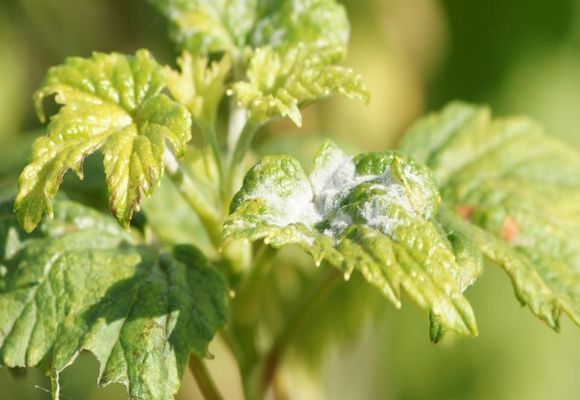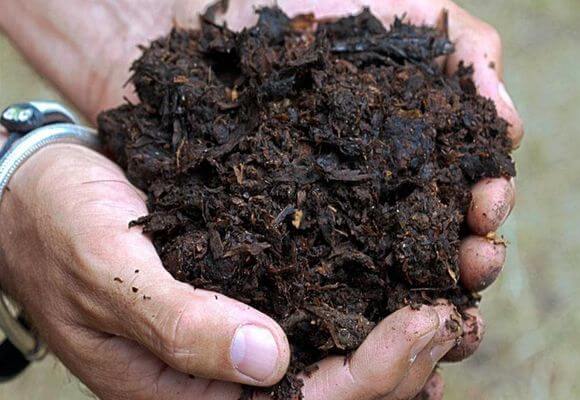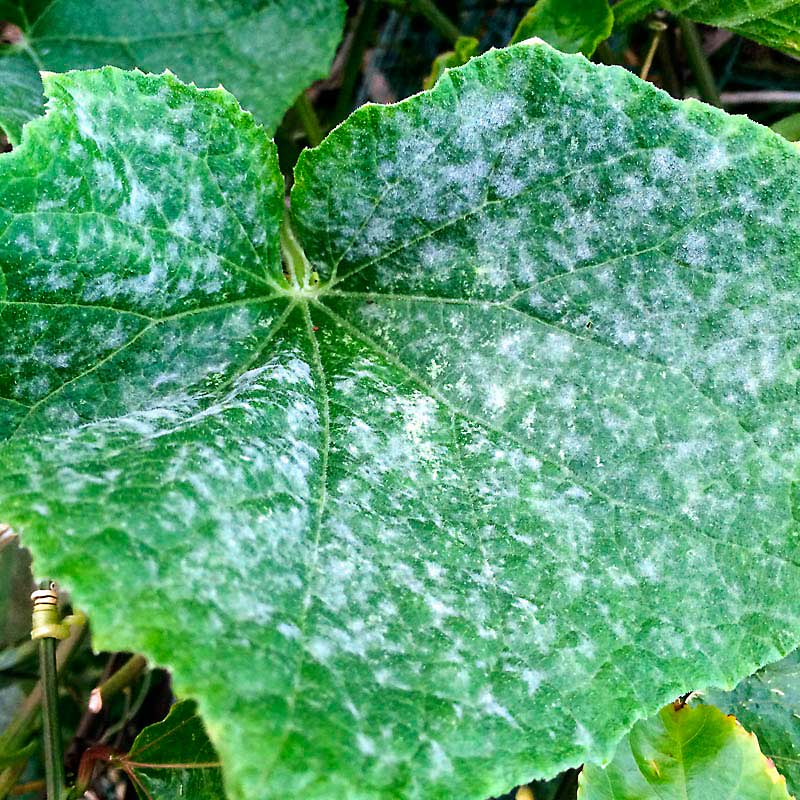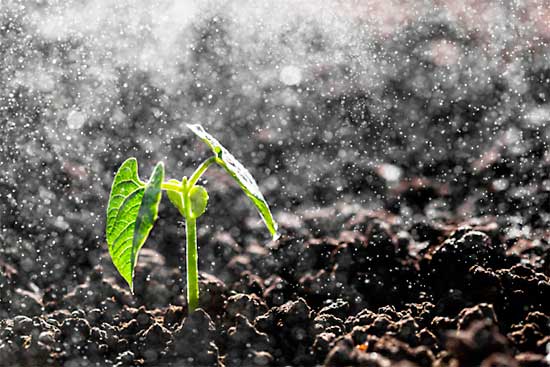Often in the summer, when the gardener is harvesting the long-awaited currant harvest, he notices unpleasant changes in the appearance plants. The color of the leaves changes, young branches grow poorly, and some berries remain unripe.
It is at this time that the best time for fungal infections to flourish comes. A particularly common and destructive disease is powdery mildew on currants.
External signs of illness
The disease is widespread throughout the country. It affects many deciduous plants: gooseberries, strawberries, delphiniums, eggplants, apple trees.
The spread of fungal spores occurs from other diseased plants through the air, through the soil in which the fungus overwintered. An outbreak of infection occurs at the beginning of the summer months.
The most favorable time for the development of mycelium occurs in July-August. The fungus affects leaves, young shoots and even berries. The growth of infection is favored by:
- maximum air humidity;
- poor lighting of currants;
- bushes growing nearby infected with a fungus;
- excess nitrogen fertilizers.
The leaves on currant bushes become covered with a whitish cobweb of mycelium in just a couple of days following heavy rain. The speed at which the infection is spreading is incredible.

Powdery mildew on currants or oidium is easily recognized by its characteristic difference - the appearance of a whitish coating on the leaves, reminiscent of flour powder. It appears after the currants have faded.
At first, the plaque only slightly covers the leaves with a cobweb and is freely washed off and cleaned off. But gradually the plaque thickens, the color becomes dirty, and spores grow on it in the form of black dots. The plaque changes color to a gray-brown color. At this stage, it is no longer possible to remove it from the surface of the plant.
Important! During the season, the mycelium produces more than 10 generations, ensuring recurrences of infection in the garden.
The fungus waits out the winter on fallen dry leaves and fallen fruits. At the beginning of the season, intact spores re-infect currants that were ill last year.

Harm from the disease
Powdery mildew on currants gradually weakens the currants and destroys them. If you do not take appropriate action, the following signs of damage appear:
- all young and growing parts of the currant are primarily affected by the fungus and slow down their development: growth point, twigs, buds, petioles, leaves;
- young branches affected by infection grow poorly, become thinner and bent, do not ripen and often dry out completely;
- the berries remain unripe and become unsuitable for food;
- the shoots are deformed, their internodes become short;
- the bush stops bearing fruit;
- currants become sensitive to frost, their winter hardiness is greatly reduced;
- the plant lacks nutrition due to weakened photosynthesis, the leaves on it become smaller and become ugly.
Destroying the infection
How to deal with powdery mildew on currants? Several methods of protection are used:
- treatment with minimally harmful agents in the initial phase of the disease;
- treatment with potent biological and chemical agents.
Important! Powdery mildew on black currant in the initial stage of the disease, it responds to simple home-made drugs.
It is necessary to create an alkaline environment that inhibits the activity of the fungus. For these purposes, it is effective to use an infusion of ash (1:10), a solution of soda (2 tbsp per 10 l), a solution of potassium permanganate (1.5 g per 10 l), a solution of iodine (10 ml per 10 l), a solution of milk (1 l per 10 l), infusion of mullein (1:9) or rotted hay (1:10).
Liquid soap is usually added to these solutions to ensure better adhesion of the product and create an alkaline environment that suppresses the activity of fungi.

How to treat the plant if the currant is covered with fungus and powdery mildew has spread to neighboring bushes? In this case, strong chemical fungicides must be used without delay.
Good reviews have been received from the use of fungicide preparations Topaz, Acrobat, Skor, Rayok, Fundazol, Previkur, Topsin-M, Quadris, Strobi. Their use must be repeated four times during the season:
- before flowering;
- after flowering;
- after picking berries;
- 2 weeks after the third application.
The fungicide is changed with each spraying to avoid addiction. Use chemicals in case of severe damage to the bush, as they are quite toxic. Such drugs are used within the specified periods and prescribed dosages.
Important! The fungicide can be used no more than three times per season. Spraying stops 3 weeks before picking berries.
Recently, gardeners are more willing to use biofungicides that are harmless to people: Fitosporin, Gamair, Baktofit, Alirin-B, Rapsol. These products can be used even when the berries are ripening.
Spraying is done in dry, cloudy and windless weather. Different drugs are used at different air temperatures, as indicated in the instructions. And these instructions must be followed. When spraying, the product must be applied from the back of the leaves.
Be sure to do early spring and late autumn treatment with a 3% solution of Nitrofen or ferrous sulfate. The same means are used to disinfect the soil after leaf fall.
![]()
Prevention
To prevent the spread of fungal infection, it is necessary to observe the entire range of measures intended for the development and protection of plants:
- agrotechnical;
- mechanical;
- biological;
- chemical methods.
When planting seedlings, it is necessary to choose varieties that are less susceptible to infection. When purchasing them, check the quarantine certificates from the sellers.
There are no immune varieties that are completely immune to this fungus. There are varieties that are less susceptible to infection:
- Ruby;
- Karelian;
- Dove;
- Glory of Leningrad;
- Primorsky champion;
- Altai giant.
- Boulogne red;
- Red Cross;
- Faya is fertile.

Reliable varieties of white currant:
- Boulogne white;
- Dutch white;
- Crystal.
Selected seedlings should first be disinfected by dipping in a 1% solution copper sulfate, for five minutes.
Agricultural technology provides for sufficient irrigation, fertilizing and proper pruning. Watering over the leaves instead of pouring water under the roots promotes the germination of fungal spores that have fallen on the leaves. This is also facilitated by excessive thickening of the bush and overfeeding it with nitrogen fertilizers.
Application of phosphorus and potash fertilizers suppresses the development of infection.
Important! Excessive pruning should be avoided. Young growing parts of the plant will become a breeding ground for the fungus.
Mechanical methods of preventing the disease include pruning leaves and branches damaged by the fungus and burning them. Autumn digging of the earth near the bush and mulching also contributes to the favorable development of the plant.
The first means for soil disinfection, complete fertilizing, protection from pests and weed germination is laying a thick layer of manure in the tree trunk circle. It must be covered with sawdust or earth to prevent it from drying out.
Prevention of powdery mildew on currants is carried out using spraying that is completely safe for humans folk remedies:
- horsetail decoction (100 g per 10 l);
- tansy decoction (300 g per 10 l);
- garlic infusion (250 g per 10 l).
The use of a 1% aqueous solution of rapeseed oil to treat an infected bush, which perfectly destroys fungal spores, has shown very good effectiveness.

Measures to combat infection, when powdery mildew has appeared on currants for more than a year, must be systematic. 1-2 treatments are not enough; 4-6 sprayings must be done due to the germination of spores of different generations of development. Early spring processing of currants on bare branches is mandatory.
Important! Before the spring awakening of currants, many gardeners pour boiling water over the currants to destroy various infections. This destroys infection spores and overwintering insect eggs.
Currant powdery mildew recedes before spraying the bushes with a 1% solution of Bordeaux mixture, copper sulfate, and colloidal sulfur. Treatment is carried out twice a season: before flowering and before the formation of ovaries.
Conclusion
Powdery mildew on currants gives the gardener many unpleasant moments. It is not possible to easily end this disease; persistent and long-term treatment is required.
You cannot spare effort and resources to destroy the fungus once it has appeared in the garden. But it is much more pleasant to grow such a strong plant that can cope with any infection on its own.
Powdery mildew is fungal disease which can take up to 70% of your harvest. The disease is also known as ash and white. When a leaf is damaged, a white coating of spores forms on it, which forms small droplets when the mycelium matures. This is how the name Powdery Mildew came about.
Powdery white mycelium develops on the above-ground parts of plants and leaves. The disease affects not only cucumbers, but also other vegetables, bushes and trees. Diseased leaves dry out, plants bend and die. The fungus develops and acts in damp climates; the optimal temperature for the life of the fungus is considered to be 16-22 degrees.

Describing in detail step by step actions of powdery mildew You can talk about the fact that first a cobweb coating of the fungus is formed (the so-called mycelium, or spores). White plaque This is only the beginning of the plant’s takeover, because it is not interested in the surface, but in the nutritional tissues of the leaf. The spores release their shoots, which penetrate through the skin of the leaf right up to the very middle of the soft fibers. With the help of shoots, it pumps out all the nutrients to the surface of the mycelium. The mycelium, with renewed vigor, throws out new shoots and so on until the leaf is completely exhausted.
What does powdery mildew look like (signs)?
The main symptom of powdery mildew is whitish-gray coating. At first, the layer of plaque is thin, as if it were just dust. But over time, the plaque becomes thick and turns black. Small brown balls appear on the upper side of the leaves.
The affected leaves of the plant take on an unnatural shape, curl upward and the surface becomes loose. When the leaves affected by the disease dry out and fall off, the plant stops breathing (that’s what leaves are for) and eventually dies.
Usually, powdery mildew begins its destructive effect from the lowest leaves, and gradually rises up the plant until it covers it entirely. Infected fruits can be recognized by the cracks that appear.
What are the causes of powdery mildew?

Powdery mildew fungus spores are found in the soil. Rest assured, there are these spores in the soil in your garden bed too. However, the disease develops only under comfortable conditions.
Ideal conditions for powdery mildew
- The soil used to dry out and then become salted;
- Water when the top layer of soil is still moist;
- Damp, cool, cloudy weather throughout the week.
- High air humidity (about 80%);
- Dense planting;
- Excess nitrogen in the soil.
Strong and beautiful bushes (in this case, cucumber bushes) are less susceptible than weak bushes.
The conditions under which fungal spores can wake up and begin their dark deeds are listed above. It can be carried through air, water, and even with our hands we can transfer spores to other plants, bushes, trees and flowers.
How to fight powdery mildew?
- We do not feed the beds where disease damage has been noticed;
- We stop any spraying (thus reducing air humidity);
- If there is such an opportunity, then we improve the lighting for plants;
- We remove weak or old leaves, thin out the plantings;
- If the plants are in a pot or container, change the top layer of soil;
- Treatment with preparations against powdery mildew, follow the instructions that come with the preparation.
Preparations against powdery mildew
- Fundazol;
- Speed;
- Topaz;
- Amistar extra;
- Acrobat MC;
- Previkur;
- Byleton;
- Sulfaride;
- Tilt CE;
- Vitaros.
Fundazol- contact action drug. The active ingredient is benomyl. Non-volatile, hazard class for humans - 2 (classified as a strong toxic substance).
Score- used as a means for the treatment and prevention of a number of plant diseases. The active ingredient is difenoconazole. Hazard class for humans - 3 (moderate toxic substance).
Topaz- systemic action. The active ingredient is penconazole. Hazard class 3.
Vitaros- sold in ampoules. Serves for treating planting material of seeds and bulbs from diseases. Active ingredient: carboxin.
Fighting powdery mildew with folk remedies without chemicals
Ash along with soap. 1 kg of ash is mixed in 10 liters of heated water (approximately 30-40°C). The liquid is infused for about 5-7 days, without forgetting to stir. Next, pour the liquid into a clean container, add a little liquid soap (soap gives stickiness, so the solution sticks well to the leaves of the plants and stays firmly there) and actually spray it. You need to treat with a solution of ash and soap 3 times, every day or every other day.
Garlic infusion. Add 25 g of chopped garlic to 1 liter of water (we need garlic juice), stir and leave for 1 day. Before spraying, do not forget to strain the infusion from floating pieces of garlic.
A solution of baking soda and soap. Dissolve 1 tablespoon of soda and half a teaspoon of liquid soap in 4 liters of water. Spraying is carried out 3 times with a rest of 7 days between them.
Mustard solution. Stir 2 tbsp dry mustard in 10 liters hot water. Spray as soon as it cools down.
Cow dung infusion. Rotten manure is poured with water in a ratio of 1 to 3. The concentrate is stirred and infused for 3 days. Before spraying the bushes, add water equal to the amount of concentrate, because as many.
In the video clip experienced gardener talks about how an infusion of cow dung helps him fight downy mildew. After all, when the fruits are already ripe, it is strictly forbidden to use chemicals, but natural ones are very possible.
Serum solution. Water is added to the serum in a ratio of 1 to 10. The plants are treated at least 3 times with a break of 3 days. A film forms on the leaves and stems that does not provide oxygen to the fungus and spores, but for the plant this film serves as an additional source of nutrition, one might say fertilizing.
Potassium permanganate. Add 2.5 g of potassium permanganate to 10 liters of water. Spray the solution 2-3 times with an interval of 5 days.
Prevention of powdery mildew
Experience shows that prevention is the best way to combat not only powdery mildew, but also many other diseases.
- Do not overfeed the soil with nitrogen fertilizers;
- Throw through dense crops;
- Do not be late with potassium-phosphorus supplements;
- Pick off old leaves that touch the ground;
- Water the plants after the top layer of soil has completely dried;
- Removal and complete cleaning of crop residues and weeds;
- Selection of varieties resistant to powdery mildew;
- Deep plowing of the soil.
The video describes methods of control and preventive work against the fungal disease powdery mildew.
☀ Good luck and all the best to you! ☀
‼Treatment of powdery mildew on indoor flowers‼ Powdery mildew can occur on many types of plants, both in open and closed ground. In indoor conditions, powdery mildew can be found on flowers such as roses, gerberas, cineraria, Kalanchoe, begonias, cissus, and violets. The cause of the disease is stagnant, humid air and sharp fluctuations in room temperature. Powdery mildew spreads when a diseased plant comes into contact with a healthy one, during watering, and is carried by insects or air flow. Treatment of powdery mildew should begin as early as possible. Powdery mildew spores fall from a diseased plant onto a healthy one and cause infection. White, slightly fluffy spots appear on the plant. They appear both on the outside and inside of the leaf, and the buds are also affected. At the beginning of the disease, these spots can be easily removed by hand, but to treat powdery mildew, simply erasing the spots from the surface of the plant is not enough. Treatment of powdery mildew is carried out with special preparations. If powdery mildew is not treated, the fungus will soon begin to bear fruit again in new areas of the plant. The areas covered with loose powdery plaque will darken, become gray, the plaque will thicken and begin to merge into spots. Affected leaves will begin to dry out and fall off. The plant will be weakened by the disease. And in the end, if measures are not taken in time, only dry branches with a coating of mycelium will remain. If you touch such a branch, you can see how the spores fly away in different directions. Powdery mildew occurs at high air humidity and a temperature of 18-20 degrees. To avoid the appearance of this scourge, you need to follow a plant nutrition regime - the nutrition should be balanced - do not overfeed with nitrogen - an excess of this substance leads to the growth of vegetative mass (greenery), and it is known that powdery mildew fungus settles primarily on young, immature shoots and leaves. We must ventilate the place where the plants stand and give them access to fresh air. ✔ Treatment of powdery mildew At home, you can use a soda solution to treat powdery mildew. It is prepared like this: 5 g of soda ash is diluted in 1 liter of water, a little soap shavings are added for better adhesion to the leaves. Spray the plant, wetting well both the top and bottom side leaves. Powdery mildew is treated with this solution once a week. In case of severe damage to the plant, fungicides are used to treat powdery mildew - the choice on the market is quite large - Topaz, Hom, Vectra, Skor, Thiovit. Treatment with drugs is carried out strictly according to the instructions, without increasing the dosage of the drug and observing all precautions. In the spring, I purchased phlox seedlings in a greenhouse and since it was too early to plant them in the ground, I brought them home and... oh, horror - soon white fluffy spots began to appear on them - powdery mildew... A most unpleasant thing... It was necessary to urgently treat powdery mildew! There is nothing difficult in processing it, except one - drugs diluted with a huge amount of water - for example, 1 ampoule (2 ml) of Topaz per 10 liters. When treating indoor flowers, this amount of solution is not needed, so it is better to divide this ampoule into several treatments. Topaz is convenient because after treating powdery mildew, it does not leave stains on the leaves; this is especially convenient for treating violets.
